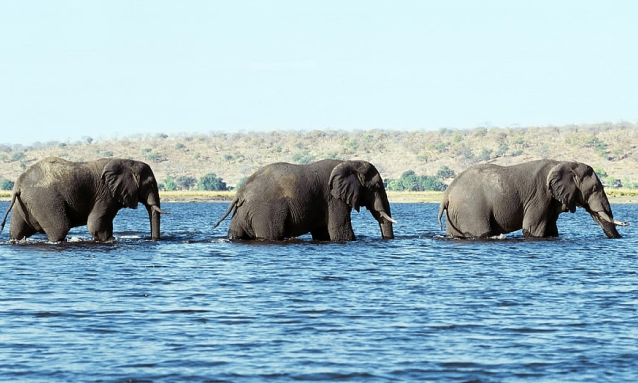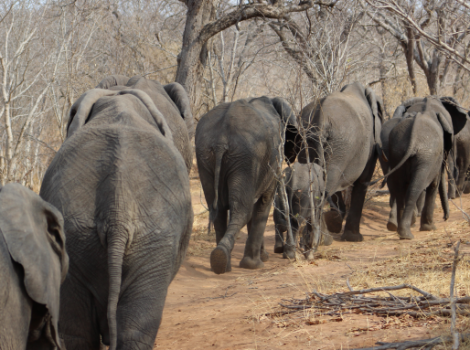
The southern African nation is home to the largest global elephant population, estimated at 130,000
Botswana was lauded at the recent global conference on endangered species trade for its exceptional management of its elephant population.
The southern African country is among countries that have adopted the Monitoring Illegal Killing of Elephant (MIKE) programme, managed by the Convention on the International Trade in Endangered Species (CITES), to conserve and manage its elephant population. MIKE is a tool developed by CITES that is used to monitor the illegal killing of elephants and also assists in clarifying the source of ivory.
Speaking during the event hosted by MIKE following the just- ended annual CITES conference, Botswana’s Minister of Environment, Natural Resources Conservation and Tourism, Philda Kereng stated that MIKE has proved to be a functional monitoring tool for the southern African nation.
She said it has been implemented within the context of broader spatial planning initiatives, including the Elephant management and Action plan 2021- 2026, adding that CITES’ MIKE is a crucial part of Botswana’s Elephant management plan.
Botswana has also developed an Ivory Stockpile Management system to ensure that its stockpile is well managed. The development for this Elephant Management Plan began in June 2018 with four national consultations resulting in the draft plan launched in December 2019, and the final plan launched in March 2021.
The Elephant Plan indicates that Botswana is resourced for the conservation and management of wildlife resources, including elephants that have decreased as funds have been diverted to other competing resources.
“Revenues generated by protected areas through tourism have dropped by up to 90 percent. Revenues generated from hunting have also been severely affected due to travel restrictions.
The development of this Plan coincided with the pandemic and, therefore, was cognisant of the emerging challenges facing wildlife managers.”
The structure of the Botswana Elephant Plan is based on a Logical Framework format, and the vision and targets are derived from a series of workshops held in 2018 and 2019 to develop this strategy.
The objectives include six key components that include: protection and law enforcement; human- elephant conflict management; management of habitats and connectivity; social and economic framework; conservation capacity and coordination and collaboration.
The overall vision of the Botswana Elephant Management Plan is to conserve optimal elephant populations while ensuring the maintenance of habitats and biodiversity, promoting the contribution of elephants to local communities and to the National Development Plan while minimising their negative impacts on rural livelihoods.
The targets in the Plan include: to maintain viable populations of elephants in Botswana through minimal interference and where necessary by adaptive management; to ensure elephant populations do not adversely impact on biodiversity conservation goals and community livelihood goals; and to involve all sectors in the realisation of the full economic potential of elephants and other wildlife resources outside the protected areas through sustainable utilisation.
The current aim is to carry out investigations and anti poaching operations and law enforcement implemented to minimise losses of Botswana’s elephants and their habitats. The hope is that losses of elephants due to illegal activities will be reduced to less than 5 percent by 2026, and to also monitor data on illegal activity, successful convictions, carcass records and trends of elephant population. To address elephant management challenges, Botswana and other elephant range states cooperate through the African Elephant Action Plan that was approved at the CITES 15th Conference of Parties (CoP-15) in Qatar in 2010.
Botswana is also part of a body of transboundary conservation areas, KAZA, which includes Botswana and regions of Namibia, South eastern corner of Angola, South eastern Zambia and western Zimbabwe. The initiative was created in cooperation with the Peace Parks Foundation and the Worldwide Fund for Nature with a strategic planning framework developed for elephant management and conservation in the KAZA region.
KAZA’s objectives are to facilitate the development of an integrated land use planning process to secure long- term ecosystem integrity and connectivity of KAZA’s elephant population; Maintain and manage KAZA’s elephants as one contiguous population; Promote and support co- existence of humans and elephants for ecological, social and economic benefits and to reduce the killing and trade in elephants and elephant products and to establish high- level decision making process on which to build the planning framework for conserving KAZA’s elephants, among others.
This article is reproduced here as part of the African Conservation Journalism Programme, funded in Angola, Botswana, Mozambique, and Zimbabwe by USAID’s VukaNow: Activity. Implemented by the international conservation organization Space for Giants, it aims to expand the reach of conservation and environmental journalism in Africa, and bring more African voices into the international conservation debate. Written articles from the Mozambican and Angolan cohorts are translated from Portuguese. Broadcast stories remain in the original language.


